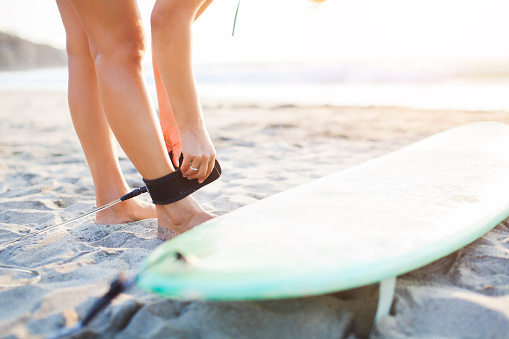The leash is nothing more than a plastic rope that connects the surfer to the surfboard. It’s constructed from a durable, elongated tube with moderate flexibility. An adjustable Velcro strap is fastened to your ankle or knee and attached to the board’s back with a tiny rope.
Please put it on a clean, dry surface. These are highly used by Australians.
The surf leash should be attached before entering the sea. You’ll get the most out of your time and effort this way. Wetness won’t affect its capacity to conform to our ankle or knee; rather, dryness ensures that it’s a snug fit and provides additional security.
It is important to know when to get a new surfboard leash
There are no expiry dates on leashes. Your leash will lose its efficacy with time and usage.
This element’s flexibility is one of the most crucial factors in determining its lifespan.
If the leash has too little elasticity, it can snap or tear your foot if you have a serious fall. There is a fine line between too much and too little flexibility. Take too long, and your board is going to be able to strike you much more easily.
Surfers who like huge waves should update their leashes after each season. On the other hand, the leash may last 3–4 years if you just surf beach waves as long as you’re careful with your materials.
Maintenance of surfboard leash
You may extend the life of your surfboard leash by following these easy instructions. The leash, like your neoprene wetsuits, must be rinsed with fresh water after each use. Also, don’t keep the leash attached to the surfboard for lengthy periods; this is a terrible habit that can cause the leash to coil and twist, causing it to lose its qualities. Last but not least, don’t keep it in direct sunlight for a long time.
You must, of course, check the condition of the rope before entering the water and maintain a backup at all times.
The surf leash’s weakest link
The rubber end of the leash, not the rope, is the most delicate element of the leash, as is often believed. This is where the majority of surf leashes break as long as you don’t have a broken fin leash.
Be careful while securing your surfboard’s leash around the tail
Leashes are often wrapped around the tail of a surfboard while putting it away. It’s a behaviour developed for the sake of convenience and to prevent the leash from slipping (especially if you have a sock cover). Stop! Weaknesses in the leash are possible, as mentioned in the previous section. It may become much more difficult to keep it in place as time goes on since it will naturally curl up.
You’ll need to determine the length of your surf leash
Many various leash lengths are available, ranging from 4′ for the smallest grom board to 12′ for the biggest longboard or SUP. If you are a beginner, you may need a shorter leash than an experienced surfer. The length of a leash should match or slightly exceed the length of the board it will be attached to. Using the same leash on both a shortboard and longboard is not recommended.
Round up to the next closest size if your board falls anywhere in the middle. Inexperienced surfers may round up as much as a foot to guarantee that they will be far from their boards while sliding in the waves. However, it is important to keep in mind that increasing your board’s “bail radius” increases the chance for your board to strike another surfer. A leash that is excessively long or thick will slow you down in the water; a leash that is too short is more likely to cause you to fall on your board or for the board to bounce and strike you when the leash is completely stretched. Length is essential.
Size of a Surfboard Leash
Competition leashes and normal leashes are two of the most frequent types of leashes used. In comparison to a standard leash, which is closer to 5/16ths of an inch thick, most competition leashes are around 3/16ths of an inch thick. For those of you who use the metric system, that’s about 4.7mm and 8mm. You should take into account the length of your board, the height of the waves, and your surfing experience and skill level when selecting the thickness.




